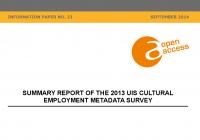The livelihoods of millions depend on cultural or creative industries of all shapes and sizes – from the weaver in a local cooperative to the crew of a major film production. Yet many countries lack the data to develop the policies to help these industries become engines for sustainable economic growth, as called for in Sustainable Development Goal 8 (SDG 8).
To fill this gap, the UIS conducts the only global survey on cultural employment. By working closely with countries around the world, the Institute is producing a unique set of internationally-comparable indicators that countries can use to answer key questions, such as: What is the size of the cultural labour force and what kinds of working conditions do these people face? What is the social status of women in cultural employment? How many artists are employed as performers?
To help countries produce the data, the UIS is also developing a series of methodological frameworks and guidelines while providing training to national statisticians.
